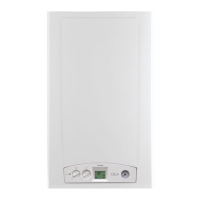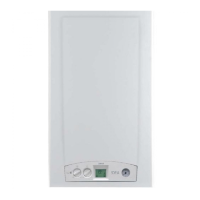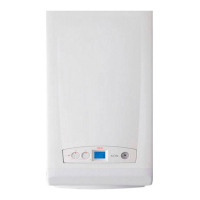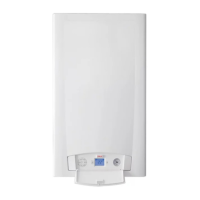25
Adjustment info
DUA plus RTN 24 - DUA plus CTN 24
11,07 - 24,01
11,07 - 24,01
12,5 - 26,7
12,5 - 26,7
20
37
13
13
1,30
0,76
NO
NO
2,2
7,7
9,8
33,0
1,32 m³/h
0,97 kg/h
2,82 m³/h
2,07 kg/h
DUA plus RTFS 24 - DUA plus CTFS 24
10,03 - 24,79
10,03 - 24,79
12,5 - 26,7
12,5 - 26,7
20
37
13
13
1,30
0,76
NO
NO
2,1
7,7
10,5
35,2
1,32 m³/h
0,97 kg/h
2,82 m³/h
2,07 kg/h
2.7 - MODIFICATION FOR
OTHER GASES
The boilers are manufactured for the type
of gas specifically required upon order.
Any subsequent conversion must be
performed by qualified technicians who will
use the kits supplied by Unical and perform
the conversion and required adjustments
for correct preparation of the boiler for use.
To convert the boiler from one type of gas
to another proceed as follows:
for conversion from natural gas to
LPG
- remove the main burner;
- disassemble the 13 injectors "
11
11
1"of the
main burner and replace them with those
with a diameter corresponding to the new
type of gas (see table “INJECTORS -
PRESSURES”);
- reassemble the main burner;
- position the jumper on the modulation PCB
in the panel board as shown in fig. 24
- remove plug ‘’A’’ (fig. 21) on the gas valve
and fully tighten max pressure adjustment
screws ‘’C"
- check the pressure value upstream the
gas valve (see table “INJECTORS -
PRESSURES”) and adjust the min. pressure
of the burner as shown in section
" ADJUSTING THE BURNER”, by screwing
the nut "B" to increase or unloosing the nut
"B" to decrease the burner pressure.
- check that the burner is functioning
properly;
- check that there are no gas leaks.
- tighten and seal the plug “A” (fig. 27) of
the modulating coil (fig. 27)
- when the conversion is completed, fill in
the label, supplied with the kit, with the
information required and stick it onto the
boiler alongside the data plate.
for conversion from LPG to natural
gas
- remove the main burner;
- disassemble the 13 injectors of the main
burner and replace them with those with a
diameter corresponding to the new type of
gas (see “INJECTORS - PRESSURES”);
- reassemble the main burner;
- get access to the modulating PCB inside
the panel board and position the jumper
shown in thefig. 23;
- remove plug ‘’A’’ (fig. 27) from the gas
valve modulating coil and adjust the
maximum and minimum output s described
in paragraph 2.6 (
AA
AA
A and
BB
BB
B)
- check that the burner is functioning
properly;
- check that there are no gas leaks.
- tighten the screw “A” of the plug of the
gas governor (fig. 27);
- when the conversion is completed, fill in
label, supplied with the kit, with the
information required and stick it onto the
boiler alongside the data plate.
fig. 28
1
NAT
GPL
JP4
POSITIONING OF THE JUMPER
NOZZLES - DIAPHRAGMS - PRESSURES - GAS FLOW RATES
The pressures at the burner indicated in the following table must be checked after the boiler has been operating for 3
minutes.
Gas nat. (G20)
Propano (G31)
Type of
gas
Supply
pressure
(mbar)
No. of
Nozzles
Ø
Diaphragme
(mm)
Ø
Nozzles
(mm)
min.
(mbar)
max
(mbar)
Burner pressure
max.
min.
Gas
consumption
Output
min. - max
(kW)
Input
min. - max
(kW)
Gas nat. (G20)
Propano (G31)
Type of
gas
Supply
pressure
(mbar)
No. of
Nozzles
Ø
Diaphragme
(mm)
Ø
Nozzles
(mm)
min.
(mbar)
max
(mbar)
Burner pressure
max.
min.
Gas
consumption
Output
min. - max
(kW)
Input
min. - max
(kW)
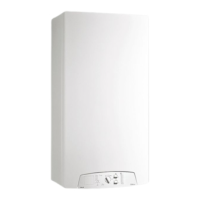
